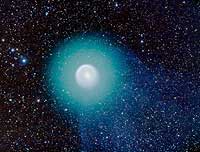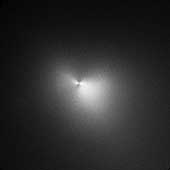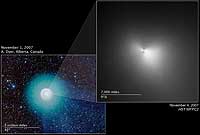
|
Table of Contents |
|
Comet Introduction
|
|
Comets |
|
Shoemaker-Levy 9
|
|
Comet Information |
Astronomers used Hubble's powerful resolution to study Comet Holmes' core for clues about how the comet brightened. The orbiting observatory's Wide Field Planetary Camera 2 (WFPC2) monitored the comet for several days, snapping images on Oct. 29, Oct. 31, and Nov. 4. Hubble's crisp "eye" can see objects as small as 33 miles (54 kilometers) across, providing the sharpest most detailed view yet of the source of the spectacular brightening.
The Hubble image shown below, taken Nov. 4, shows the heart of the comet. The central portion of the image has been specially processed to highlight variations in the dust distribution near the nucleus. About twice as much dust along lies along the east-west direction (the horizontal direction) as along the north-south direction (the vertical direction), giving the comet a "bow tie" appearance.

The composite color image shown at the top, taken Nov. 1 by an amateur astronomer, shows the complex structure of the entire coma, consisting of concentric shells of dust and a faint tail emanating from the comet's right side.
The nucleus-the small solid body that is the ultimate source of all the comet's activity-is still swaddled in bright dust, even 12 days after the spectacular outburst. "Most of what Hubble sees is sunlight scattered from microscopic particles," explained Hal Weaver of The Johns Hopkins University Applied Physics Laboratory in Laurel, Md., who led the Hubble investigation. "But we may finally be starting to detect the emergence of the nucleus itself in this final Hubble image."
Hubble first observed Comet 17P/Holmes on June 15, 1999, when there was virtually no dusty shroud around the nucleus. From that observation, astronomers deduced that the nucleus had a diameter of approximately 2.1 miles (3.4 kilometers), about the length of New York City's Central Park. Astronomers hope to use the new Hubble images to determine the size of the comet's nucleus to see how much of it was blasted away during the outburst.
Hubble's two earlier snapshots of Comet Holmes also showed some interesting features. On Oct. 29, the telescope spied three "spurs" of dust emanating from the nucleus, while the Hubble images taken on Oct. 31 revealed an outburst of dust just west of the nucleus.
The Hubble images, however, do not show any large fragments near the nucleus of Comet Holmes, unlike the case of Comet 73P/Schwassmann-Wachmann 3 (SW3). In the spring of 2006 Hubble observations revealed a multitude of "mini-comets" ejected by SW3 after the comet increased dramatically in brightness.
Ground-based images of Comet Holmes show a large, spherically symmetrical cloud of dust that is offset from the nucleus, suggesting that a large fragment did break off and subsequently disintegrated into tiny dust particles after moving away from the main nucleus.
Unfortunately, the huge amount of dust near the comet's nucleus and the comet's relatively large distance from Earth (149 million miles, or 1.6 astronomical units, for Holmes versus 9 million, or 0.1 astronomical unit for SW3), make detecting fragments near Holmes nearly impossible right now, unless the fragments are nearly as large as the nucleus itself.
The Hubble Comet Holmes observing team comprises H. Weaver and C. Lisse (The Johns Hopkins University Applied Physics Laboratory); P. Lamy (Laboratoire d'Astrophysique de Marseille, France); I. Toth (Konkoly Observatory, Hungary); M. Mutchler (Space Telescope Science Institute); W. Reach (California Institute of Technology); and J. Vaubaillon (California Institute of Technology).
 Hubble Zooms in on Heart of Mystery Comet
Hubble Zooms in on Heart of Mystery Comet
Composite image of Comet 17P/Holmes.
(Courtesy NASA, ESA, JHU/APL)
 Ground-based Image of Comet Holmes
Ground-based Image of Comet Holmes
The ground-based image of Comet 17P/Holmes was taken November 1, 2007, by astrophotographer Alan Dyer. The observations were made in southern Alberta, Canada with a 105mm apochromatic refractor at f/5 with a Canon 20Da camera at ISO400. Field is about 2.5 x 1.5 degrees.
(Courtesy NASA, ESA, and A. Dyer)
 Hubble Image of Holmes
Hubble Image of Holmes
Hubble Space Telescope Image of Comet Holmes Taken on November 4.
(Courtesy NASA, ESA, JHU/APL)